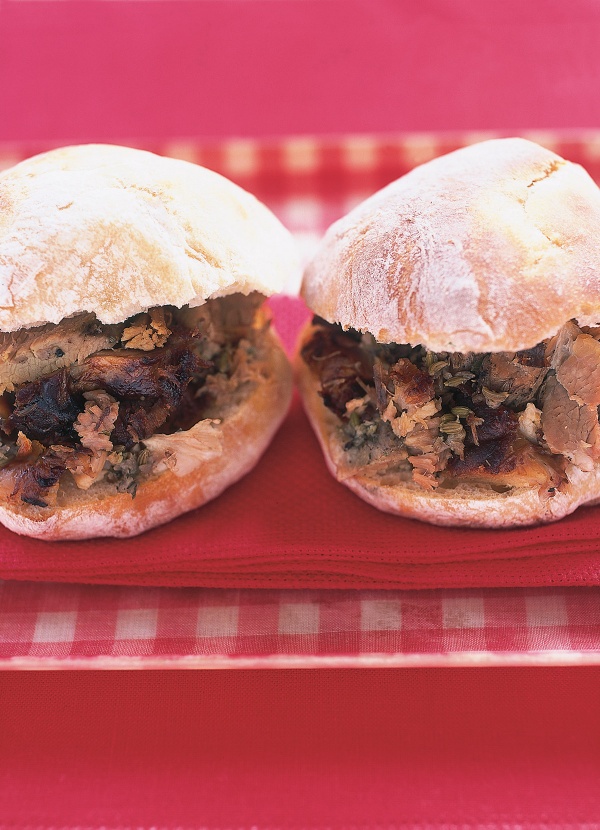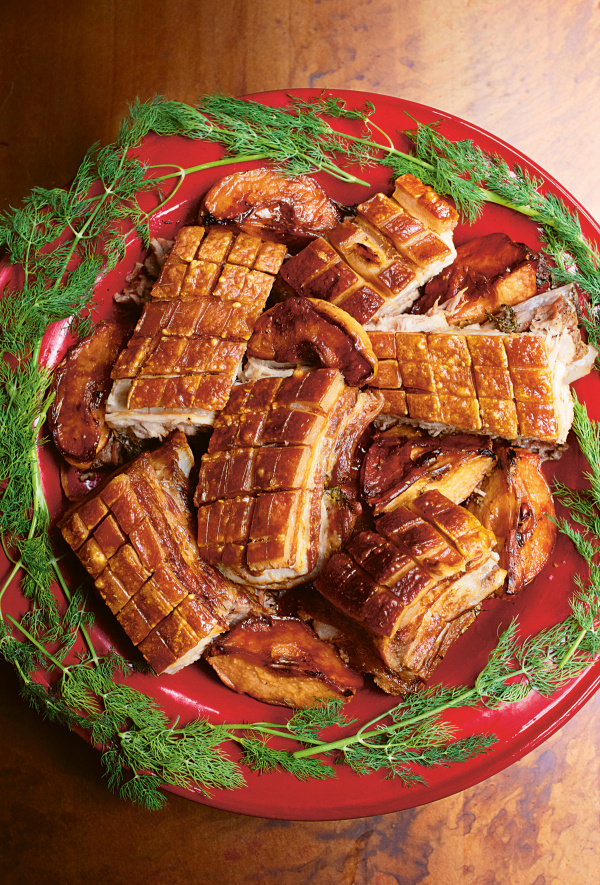Porchetta
by Nigella. Featured in NIGELLA SUMMERIntroduction
This is a domestic take on the Italian marketplace staple of roast suckling pig, and quite my favourite thing to eat in Italy. I’ve specified pork shoulder, but really you can get any cut of pork you want: the important thing is that it’s opened out to form a roughly oblong slab or sheet, which you then smear with onion, fennel seeds, rosemary, bay leaves, ground cloves and garlic, then you roll it up so that the flavourings snake their way through the whole of the joint. Tie it with string, roast it for a good long time then, once it’s out of the oven, leave it till it’s still just warm then slice it thickly and wodge it into buns. Of course you can just carve it and eat it more sedately with knife and fork, but for the echt experience, pretty well unbeatable, you need to taste this aromatic, slow-cooked pork in sandwich form at least once. I tend to keep within the authentic register and get small, individual ciabatta rolls, but even in thick slices of white English bread it’s dreamy. But don’t use a plastic sliced loaf, which will go too pappy, and avoid baguettes: that robust crunch is not what we’re going for here.
This is a domestic take on the Italian marketplace staple of roast suckling pig, and quite my favourite thing to eat in Italy. I’ve specified pork shoulder, but really you can get any cut of pork you want: the important thing is that it’s opened out to form a roughly oblong slab or sheet, which you then smear with onion, fennel seeds, rosemary, bay leaves, ground cloves and garlic, then you roll it up so that the flavourings snake their way through the whole of the joint. Tie it with string, roast it for a good long time then, once it’s out of the oven, leave it till it’s still just warm then slice it thickly and wodge it into buns. Of course you can just carve it and eat it more sedately with knife and fork, but for the echt experience, pretty well unbeatable, you need to taste this aromatic, slow-cooked pork in sandwich form at least once. I tend to keep within the authentic register and get small, individual ciabatta rolls, but even in thick slices of white English bread it’s dreamy. But don’t use a plastic sliced loaf, which will go too pappy, and avoid baguettes: that robust crunch is not what we’re going for here.

Share or save this
Ingredients
Makes: enough to fill 8-10 buns
- 2 kilograms neck end pork shoulder (derinded, boned and butterflied)
- 3 tablespoons olive oil
- 1 large onion (chopped)
- 3 cloves garlic (finely chopped)
- 2 tablespoons fennel seeds
- 2 large sprigs fresh rosemary (finely chopped)
- 4 fresh bay leaves (finely chopped)
- 1 teaspoon ground cloves
- 1 teaspoon salt
- 8 black peppercorns (coarsely crushed)
- 8 - 10 or so ciabatta buns / rolls
- 4½ pounds pork butt (derinded, boned and butterflied)
- 3 tablespoons olive oil
- 1 large onion (chopped)
- 3 cloves garlic (finely chopped)
- 2 tablespoons fennel seeds
- 2 large sprigs fresh rosemary (finely chopped)
- 4 fresh bay leaves (finely chopped)
- 1 teaspoon ground cloves
- 1 teaspoon salt
- 8 black peppercorns (coarsely crushed)
- 8 - 10 or so ciabatta buns / rolls
Method
- Lay the pork out on a chopping board and cover with clingfilm. Using either a rolling pin or meat mallet pound the meat to an even 3cm thickness (1inch) or as near as you can get.
- Heat 2 tablespoons of the oil in a frying pan and cook the onion for a few minutes until it's beginning to soften. Add half the garlic, half the fennel seeds, all the rosemary and bay leaves, half the ground cloves, the salt and pepper, and cook for a minute more, then transfer to a plate and leave it to cool.
- Spread this cooled mixture over the pork, rubbing it in well, then roll up the pork tightly and secure at regular intervals with string. If you're as cack-handed as I am, you might find it helpful to have someone to keep a steady finger on the string as you tie it, but it's not impossible single-handed.
- Mix together the remaining garlic, fennel and ground cloves with the remaining olive oil. Rub this over the surface of the pork. Loosely cover with clingfilm and leave to steep in the fridge overnight or for 24 hours. But do remember to take it out of the fridge a good hour before you start cooking as the meat has to be at room temperature when it goes into the oven.
- So, preheat the oven to 180°C/160°C Fan/gas mark 4/350℉, and put the pork in a roasting tin and cook for 4 hours. It may need covering towards the end of the cooking time, so look at it after about 3 — if it looks as if it's beginning to blacken too much (a little bit of herby burning just adds to the depth of flavour), tent it loosely with foil for the last hour.
- Remove from the oven and leave, uncovered, for an hour or so before slicing it, stuffing it into whatever rolls or bread you're using, then just sink your teeth into these melting-bellied, dangerously compulsive bulging buns.
- Lay the pork out on a chopping board and cover with clingfilm. Using either a rolling pin or meat mallet pound the meat to an even 3cm thickness (1inch) or as near as you can get.
- Heat 2 tablespoons of the oil in a frying pan and cook the onion for a few minutes until it's beginning to soften. Add half the garlic, half the fennel seeds, all the rosemary and bay leaves, half the ground cloves, the salt and pepper, and cook for a minute more, then transfer to a plate and leave it to cool.
- Spread this cooled mixture over the pork, rubbing it in well, then roll up the pork tightly and secure at regular intervals with string. If you're as cack-handed as I am, you might find it helpful to have someone to keep a steady finger on the string as you tie it, but it's not impossible single-handed.
- Mix together the remaining garlic, fennel and ground cloves with the remaining olive oil. Rub this over the surface of the pork. Loosely cover with clingfilm and leave to steep in the fridge overnight or for 24 hours. But do remember to take it out of the fridge a good hour before you start cooking as the meat has to be at room temperature when it goes into the oven.
- So, preheat the oven to 180°C/160°C Fan/gas mark 4/350℉, and put the pork in a roasting tin and cook for 4 hours. It may need covering towards the end of the cooking time, so look at it after about 3 — if it looks as if it's beginning to blacken too much (a little bit of herby burning just adds to the depth of flavour), tent it loosely with foil for the last hour.
- Remove from the oven and leave, uncovered, for an hour or so before slicing it, stuffing it into whatever rolls or bread you're using, then just sink your teeth into these melting-bellied, dangerously compulsive bulging buns.
Additional Information
MAKE AHEAD / STORE:
Pork shoulder should be smeared with the herb paste a day in advance of cooking. Cover tightly and keep in the fridge. Remove from the fridge about 1 hour before cooking.
Leftovers will keep, covered, in the fridge for up to 3 days. Refrigerate as soon as possible and within 2 hours of cooking. Eat cold, in sandwiches.
MAKE AHEAD / STORE:
Pork shoulder should be smeared with the herb paste a day in advance of cooking. Cover tightly and keep in the fridge. Remove from the fridge about 1 hour before cooking.
Leftovers will keep, covered, in the fridge for up to 3 days. Refrigerate as soon as possible and within 2 hours of cooking. Eat cold, in sandwiches.







Tell us what you think
Thank you {% member.data['first-name'] %}.
Explore more recipesYour comment has been submitted.